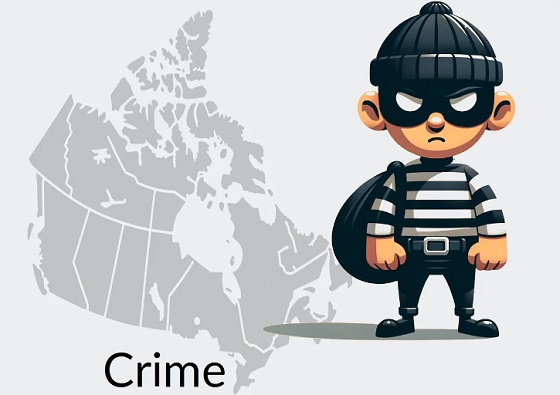Crime
Has Canada’s Criminal Code Lost Its Way?

From The Audit
I am neither a lawyer nor the son of a lawyer and, thankfully, I’ve never been dragged through the justice system as a participant. But that doesn’t mean I can’t have thoughts.
My recent post on auto theft conviction rates ended with a suggestion that the size and complexity of Canada’s Criminal Code might be contributing to systemic problems with our courts – including suffocating inefficiencies. I’d like to explore that idea a bit more here.
First of all though, complexity is not the driver of most criminal behavior. You don’t need a law degree to know that you shouldn’t steal someone’s car or break his nose in a barroom brawl. And anyone with a grade three education should realize that government program fraud isn’t exactly saintly behaviour.
But overly complex laws can be responsible for some serious problems. Consider how clarity is actually a cornerstone of justice. In Canada, for instance, the Void for Vagueness Doctrine holds that a law is invalid if it’s too vague for the average person to understand. That’s because such laws fail to provide “fair notice” of what’s prohibited and clear standards for enforcement.
Similarly, if accused criminals can demonstrate that the complexity or ambiguity of the statute led them to reasonably believe their conduct was lawful, those laws might fail the necessary mens rea requirement for certain offences.
Unfortunate illustrations of this problem make appearances in some recent Liberal government legislation:
- Online Harms Act (Bill C-63) fails to provide a clear definition for “online harm”. This makes it impossible for citizens to anticipate how the new Digital Safety Commission will enforce the law.
- Online Streaming Act (Bill C-11) appears to require streaming services (like YouTube) to regulate user-generated content using an undefined standard.
- Online News Act (Bill C-18) could affect how news is shared and accessed online, potentially influencing the availability and distribution of Canadian news.
Of those, at least C-63 and C-11 – in their current form – could expose individuals to significant criminal and civil penalties without providing clarifying details.
Here’s another example. Section 423 of the Criminal Code prohibits intimidation:
423(1) Every one is guilty of an indictable offence and liable to imprisonment for a term of not more than five years or is guilty of an offence punishable on summary conviction who, wrongfully and without lawful authority, for the purpose of compelling another person to abstain from doing anything that he or she has a lawful right to do, or to do anything that he or she has a lawful right to abstain from doing…blocks or obstructs a highway.
And Section 430 prohibits “mischief”, whose definition includes:
interfering with the lawful use, enjoyment, or operation of property.
Just playfully attaching a sticker to someone’s car could lead to charges even if there was no intent to cause harm (by, say, damaging the car’s paint).
The problem here is that both Sections 423 and 430 are, to put it mildly, inconsistently enforced. This is something I’ve already discussed in my Limits of Legal Protest post. Participants in recent pro-Hamas protests flagrantly blocked lawful access to roads, parks, and public buildings for weeks at a time in cities across the country. That’s a clear Section 423 and 430 violation. And yet, of the many hundreds of participants, only a handful were ever arrested and, to my knowledge, none was charged with mischief or intimidation.
Now I know exactly what you’re thinking: “Come on Clinton, what about 430(7)?”
No person commits mischief within the meaning of this section by reason only that he attends at or near or approaches a dwelling-house or place for the purpose only of obtaining or communicating information.
Weren’t those protesters just there to communicate information (“from the river to the sea…”)? Well I’m actually not sure how much meaningful communication was happening at those gatherings. Dialog didn’t seem to be their primary focus. But the legal issue wasn’t where they chose to stand, it was the fact that they actively and intentionally prevented the lawful use, enjoyment, or operation of property – both private and public.
Now, in that context, is it reasonable to prosecute any acts of mischief or intimidation anywhere in Canada? Couldn’t a person reasonably argue that he was under the informed opinion that Canadian police largely ignored such offences?
As the Criminal Code grows, its internal complexity is bound to increase along with it. Comparing the PDF version of the June 15, 2011 version of the Code (1,025 pages) to the most recent version (1,349 pages) gives us a sense of the changes that are happening in both government and society as a whole. More than 226,000 words (in both French and English) were added over that time, a 31 percent increase. Revisions included updates concerning firearms and weapons, remote proceedings, indigenous rights, organized crime and terrorism, and palliative care.
All that’s not necessarily a bad thing. But when poorly-written legislation (like C-11) makes it into the books and perfectly fine legislation (like Section 430) is enforced unevenly, then we’re asking for trouble. A competent government should be able to do better than that.
Crime
Canada Seizes 4,300 Litres of Chinese Drug Precursors Amid Trump’s Tariff Pressure Over Fentanyl Flows

In what appears to be the second-largest Chinese precursor-chemical seizure in British Columbia in the past decade, Canadian border and police officials announced they intercepted more than 4,300 litres of chemicals used to manufacture fentanyl and other synthetic drugs at a notoriously troubled port in Delta, B.C.
The announcement of a seizure that occurred in May 2025 comes amid President Donald Trump’s continuing pressure on Ottawa to crack down on fentanyl trafficking in the province — which U.S. officials say has become a key production and shipment point for Chinese and Mexican traffickers.
The seizure — announced jointly by the Canada Border Services Agency (CBSA) and the RCMP — underscores the scale and persistence of global trafficking networks funnelling illicit materials into Canada’s drug markets.
According to the agencies, border officers examined two marine containers that arrived from China in mid-May, both bound for Calgary, Alberta. Acting on intelligence developed by CBSA’s Pacific Region, officers discovered 3,600 litres of 1,4 Butanediol, a key ingredient for producing GHB, often known as the “date-rape drug”; 500 litres of Propionyl Chloride, a chemical precursor used to synthesize fentanyl; and 200 litres of Gamma Butyrolactone (GBL), another controlled intoxicant.
The chemicals were concealed inside 60 clear jugs and 20 blue drums within the containers. Investigators believe the shipment was intended for use in clandestine drug laboratories. The RCMP confirmed that an investigation into the importation network remains ongoing.
The seizure comes amid growing concern about Canada’s port security, particularly in Metro Vancouver, where experts and local officials say criminal networks are exploiting gaps in federal enforcement.
The Delta seizure follows a series of major CBSA operations targeting precursor chemicals at Pacific ports. In May 2022, CBSA officers in the Metro Vancouver District examined a container from China declared as “toys” and discovered 1,133 kilograms of the fentanyl-precursor chemical Propionyl Chloride, with the potential to produce more than a billion doses of fentanyl.
Public Safety Canada also reported that in the first half of 2021, CBSA seized more than 5,000 kilograms of precursor chemicals, compared with just 512 kilograms in 2020 — reflecting what officials called a “dramatic escalation” in attempts to smuggle fentanyl inputs into the country.
In 2023, the City of Delta released a report highlighting major vulnerabilities at port terminal facilities, warning that there is “literally no downside” for organized criminals to infiltrate port operations. The report noted that British Columbia’s provincial threat assessment rated ports as highly susceptible to corruption and organized-crime infiltration.
At the time, Delta Mayor George Harvie called the lack of a dedicated national port-policing force “a threat to national security.” In comments to the Canadian Press, Harvie said that while Canada’s ports fall under federal jurisdiction, the “total absence of uniformed police at the facilities makes them obvious targets for criminal elements — from Mexican drug cartels to biker gangs.”
“We’re witnessing a relentless flow of illegal drugs, weapons and contraband into Canada through our ports, and that threatens our national security,” Harvie said.
The Port of Vancouver complex, which includes major terminals in Delta, Surrey, and Vancouver, handles roughly three million containers annually, with millions more expected as port expansion plans move forward.
The Delta report reiterated how difficult it has become to police these sprawling operations since the Ports Canada Police were disbanded in 1997. More than a quarter-century later, Harvie said, the consequences of that decision are now “alarmingly clear.”
The CBSA announcement today comes as U.S. President Donald Trump has imposed tariffs on Canadian exports, accusing Ottawa of failing to interdict the flow of fentanyl and precursor chemicals trafficked through British Columbia ports. Washington has repeatedly pressed Canada to strengthen port enforcement and anti-money-laundering controls, citing the West Coast’s role in China- and Mexico-linked trafficking networks.
Simultaneously, in trade negotiations with Beijing, Mr. Trump announced a reduction in tariffs tied to the fentanyl supply chain — raising concern that Washington has eased pressure on China, the primary source of finished fentanyl now responsible for hundreds of thousands of overdose deaths across North America.
Subscribe for free to receive new posts and support my work.
For the full experience, please upgrade your subscription and support a public interest startup.
We break international stories and this requires elite expertise, time and legal costs.
Crime
Suspect caught trying to flee France after $100 million Louvre jewel robbery

French authorities have arrested two men accused of involvement in the recent heist at the Louvre Museum that stunned Paris last week. One of the suspects was caught Saturday night at Charles de Gaulle Airport as he tried to board a flight to Algeria, French outlet Le Parisien reported. Both men, described as being in their 30s and from Seine-Saint-Denis — a crime-ridden suburb north of Paris — were taken into custody on charges of “organized gang robbery” and “conspiracy to commit a crime.” Two other members of the crew remain on the run.
Authorities say the arrests followed a tip that one suspect was attempting to flee the country. Police intercepted him at the airport, while a second man was tracked down hours later in Paris. Investigators have yet to recover any of the stolen Crown Jewels. The four-man gang — clad in yellow vests and motorcycle helmets — used a cherry picker to scale the walls of the Louvre’s Apollo Gallery before smashing glass displays with chainsaws in front of stunned onlookers. The entire operation reportedly took less than four minutes.
The thieves made off with eight pieces from France’s historic Crown Jewels collection, including a sapphire diadem, necklace, and earring linked to 19th-century Queens Marie-Amélie and Hortense. Among the most valuable items taken were Empress Eugénie’s diamond diadem and a massive diamond-and-emerald corsage brooch. One piece — Eugénie’s emerald-set imperial crown with over 1,300 diamonds — was later found outside the museum, damaged but recoverable. The crew abandoned and torched the cherry picker before escaping on scooters.
Forensic teams have since gathered more than 150 DNA, fingerprint, and hair samples from the scene and other sites across Paris. One key piece of evidence — hair found in a motorcycle helmet — is believed to belong to the first thief who entered the museum. Investigators suspect the men were experienced criminals hired to carry out the robbery for a private buyer.
The suspects are being held at Paris police headquarters, where they can be detained for up to 96 hours before charges are formally filed. Interior Minister Laurent Nuñez praised police for their swift action, writing on X: “I extend my warmest congratulations to the investigators who have worked tirelessly as I requested and who have always had my full confidence… We keep going!!”
In the wake of the heist, France’s government has ramped up security at major cultural sites. The remaining Crown Jewels have been moved to an ultra-secure vault at the Bank of France. A forthcoming audit by France’s Court of Auditors reportedly found that the Louvre’s video surveillance systems were woefully outdated — with security spending in 2024 lower than two decades earlier.
Paris prosecutors, however, criticized the media for leaking details about the arrests. “This revelation can only hinder the investigative efforts of the 100 or so mobilised investigators… It is too early to provide any specific details,” said prosecutor Laure Beccuau.
“French-crown-jewels” byMichael Reeve licensed under CC BY-SA 3.0 DEED.
-

 Internet2 days ago
Internet2 days agoMusk launches Grokipedia to break Wikipedia’s information monopoly
-

 Business2 days ago
Business2 days agoBill Gates walks away from the climate cult
-

 Alberta1 day ago
Alberta1 day agoNobel Prize nods to Alberta innovation in carbon capture
-

 Business14 hours ago
Business14 hours agoCanada’s attack on religious charities makes no fiscal sense
-

 International3 hours ago
International3 hours agoPrince Andrew banished from the British monarchy
-

 Business17 hours ago
Business17 hours agoWhen Words Cook the Books: The Politics of ‘Investment-Speak’
-

 Bruce Dowbiggin17 hours ago
Bruce Dowbiggin17 hours agoGet Ready: Your House May Not Be Yours Much Longer
-

 Censorship Industrial Complex1 day ago
Censorship Industrial Complex1 day agoPro-freedom group to expose dangers of Liberal ‘hate crime’ bill before parliamentary committee












